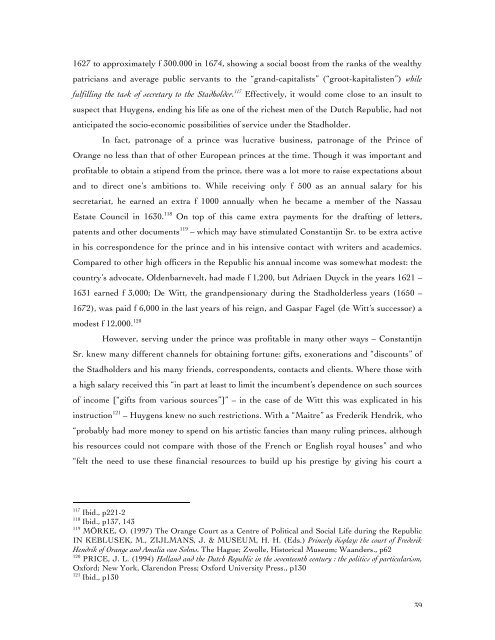Christiaan Huygens – A family affair - Proeven van Vroeger
Christiaan Huygens – A family affair - Proeven van Vroeger
Christiaan Huygens – A family affair - Proeven van Vroeger
Create successful ePaper yourself
Turn your PDF publications into a flip-book with our unique Google optimized e-Paper software.
1627 to approximately f 300.000 in 1674, showing a social boost from the ranks of the wealthy<br />
patricians and average public ser<strong>van</strong>ts to the “grand-capitalists” (“groot-kapitalisten”) while<br />
fulfilling the task of secretary to the Stadholder. 117 Effectively, it would come close to an insult to<br />
suspect that <strong>Huygens</strong>, ending his life as one of the richest men of the Dutch Republic, had not<br />
anticipated the socio-economic possibilities of service under the Stadholder.<br />
In fact, patronage of a prince was lucrative business, patronage of the Prince of<br />
Orange no less than that of other European princes at the time. Though it was important and<br />
profitable to obtain a stipend from the prince, there was a lot more to raise expectations about<br />
and to direct one’s ambitions to. While receiving only f 500 as an annual salary for his<br />
secretariat, he earned an extra f 1000 annually when he became a member of the Nassau<br />
Estate Council in 1630. 118 On top of this came extra payments for the drafting of letters,<br />
patents and other documents 119 <strong>–</strong> which may have stimulated Constantijn Sr. to be extra active<br />
in his correspondence for the prince and in his intensive contact with writers and academics.<br />
Compared to other high officers in the Republic his annual income was somewhat modest: the<br />
country’s advocate, Oldenbarnevelt, had made f 1,200, but Adriaen Duyck in the years 1621 <strong>–</strong><br />
1631 earned f 3,000; De Witt, the grandpensionary during the Stadholderless years (1650 <strong>–</strong><br />
1672), was paid f 6,000 in the last years of his reign, and Gaspar Fagel (de Witt’s successor) a<br />
modest f 12,000. 120<br />
However, serving under the prince was profitable in many other ways <strong>–</strong> Constantijn<br />
Sr. knew many different channels for obtaining fortune: gifts, exonerations and “discounts” of<br />
the Stadholders and his many friends, correspondents, contacts and clients. Where those with<br />
a high salary received this “in part at least to limit the incumbent’s dependence on such sources<br />
of income [“gifts from various sources”]” <strong>–</strong> in the case of de Witt this was explicated in his<br />
instruction 121 <strong>–</strong> <strong>Huygens</strong> knew no such restrictions. With a “Maitre” as Frederik Hendrik, who<br />
“probably had more money to spend on his artistic fancies than many ruling princes, although<br />
his resources could not compare with those of the French or English royal houses” and who<br />
“felt the need to use these financial resources to build up his prestige by giving his court a<br />
117 Ibid., p221-2<br />
118 Ibid., p137, 143<br />
119 MÖRKE, O. (1997) The Orange Court as a Centre of Political and Social Life during the Republic<br />
IN KEBLUSEK, M., ZIJLMANS, J. & MUSEUM, H. H. (Eds.) Princely display: the court of Frederik<br />
Hendrik of Orange and Amalia <strong>van</strong> Solms. The Hague; Zwolle, Historical Museum; Waanders., p62<br />
120 PRICE, J. L. (1994) Holland and the Dutch Republic in the seventeenth century : the politics of particularism,<br />
Oxford; New York, Clarendon Press; Oxford University Press., p130<br />
121 Ibid., p130<br />
39


